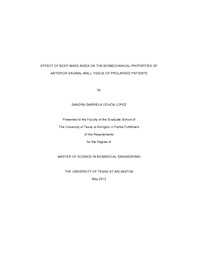
ATTENTION: The works hosted here are being migrated to a new repository that will consolidate resources, improve discoverability, and better show UTA's research impact on the global community. We will update authors as the migration progresses. Please see MavMatrix for more information.
Show simple item record
| dc.contributor.author | Ochoa Lopez, Sandra Gabriela | en_US |
| dc.date.accessioned | 2013-07-22T20:13:58Z | |
| dc.date.available | 2013-07-22T20:13:58Z | |
| dc.date.issued | 2013-07-22 | |
| dc.date.submitted | January 2013 | en_US |
| dc.identifier.other | DISS-12147 | en_US |
| dc.identifier.uri | http://hdl.handle.net/10106/11827 | |
| dc.description.abstract | Anterior Vaginal Wall (AVW) prolapse is a bothersome condition that affects thousands of women. Its onset and progression is not well understood but is thought to be multifactorial. Biomechanical properties of AVW tissue from prolapsed patients have been measured in-vitro using excised tissue specimens with great variability found in results, possibly from differences in tissue preparation, setting, preservation time, temperature, hydration, etc. In-vivo test using a BTC-2000TM cutometer-like device has recently been developed that measures the tissue uplift under suction pressure load. In this study, a systematical analysis of biomechanical property measurements from AVW tissues was done, including both in-vitro and in-vivo tests, derived from 28 patients requiring vaginal surgical repair. Immediately after in-vivo measurement, AVW tissue sample was excised from consenting patients and subjected to in-vitro uniaxial tensile test to measure its intrinsic biomechanical properties. Data from both in-vivo and in-vitro tests were then correlated with each of four known risk factors: obesity, parity, age and menopause. Results from in-vitro test showed that obesity could affect AVW biomechanical properties, with overweight patients (BMI > 25, n=15) developing higher tissue stiffness than patients with normal weight (BMI < 25, n=13), possibly due to tissue remodeling. Patients with higher parity numbers (3-6) are seen to have higher tissue compliance than patients in the other group (0-2). Although age and menopause did not show statistically significant differences in biomechanical properties, they exhibit trend lines suggesting alterations in tissue biomechanical properties associated with these factors. Combining data from both in-vitro and in-vivo tests could aid in the development of improved prosthetic meshes and better planning for surgical repair. | en_US |
| dc.description.sponsorship | Chuong, Cheng-Jen | en_US |
| dc.language.iso | en | en_US |
| dc.publisher | Biomedical Engineering | en_US |
| dc.title | Effect Of Body Mass Index On The Biomechanical Properties Of Anterior Vaginal Wall Tissue Of Prolapsed Patients | en_US |
| dc.type | M.S. | en_US |
| dc.contributor.committeeChair | Chuong, Cheng-Jen | en_US |
| dc.degree.department | Biomedical Engineering | en_US |
| dc.degree.discipline | Biomedical Engineering | en_US |
| dc.degree.grantor | University of Texas at Arlington | en_US |
| dc.degree.level | masters | en_US |
| dc.degree.name | M.S. | en_US |
Files in this item
- Name:
- OchoaLopez_uta_2502M_12147.pdf
- Size:
- 5.985Mb
- Format:
- PDF
This item appears in the following Collection(s)
Show simple item record


